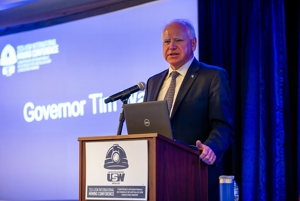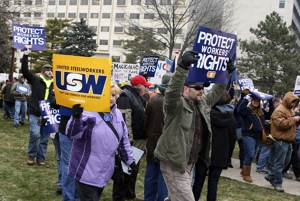Minnesota Home Care Workers Announce Victory In Historic Union Election
“Despite every obstacle put in our way, we stuck to our promise to keep fighting until we were able to exercise our democratic right to let home care workers decide for themselves whether to form a union,” said Sumer Spika, a home care worker from St. Paul.
To gain the right to organize, the workers mobilized to push the legislature to change state law. They endured court challenges bankrolled by the National Right to Work Committee. Workers knocked on hundreds of doors and engaged in thousands of conversations to gain support for the union.
They celebrated that Tuesday when the results were announced before a large crowd at the Minnesota AFL-CIO Labor Pavilion at the Minnesota State Fair.
“After years of struggle just to get a vote, today we are so excited to have won our union!” said Rosemary Van Vickle, a home care worker from Crosby. “With our collective voice, we will be stronger in our fight for improvements for both workers and the people we serve.”
Key issues in SEIU’s organizing drive were better pay and benefits for home care workers, more access to training and improved quality of care for their clients.
The workers will now begin the process of negotiating with the state on these issues. The members of the union are personal care assistants and other home care workers providing direct support services through client-directed, government-funded programs.
“When workers voted yes for their union, they were voting ‘Yes’ for a better life not only for themselves, but also for families like mine,” said Nikki Villavicencio, a home care recipient from Maplewood who attended the press conference with her husband and daughter.
“The high turnover in this field, from the low pay and lack of benefits, causes turmoil for families,” she added. “When we undervalue the workers, we undervalue families like mine. With a voice through a union, we are confident we will finally see the changes needed to make this work invisible no more!”
The home care workers’ efforts echoed the struggles of the past. Miners on Minnesota’s Iron Range were subjected to decades of attacks by employers and law enforcement before finally winning union representation in the 1930s. Bloody battles by Minneapolis truckers and warehouse workers in 1934 – including four workers who were killed – were among the factors that led to passage of the country’s most sweeping labor law, the National Labor Relations Act, in 1935.
Teachers whose work was undervalued walked out of their classrooms in St. Paul in 1946 and Minneapolis in 1970 in illegal strikes that eventually led to huge reforms in public education and public sector labor law. And a strike by Minnesota nurses in 1984 drew national attention to the problems facing workers in health care and female workers in particular.
SEIU Minnesota’s new bargaining unit could contain up to all 26,000 workers, but joining is voluntary – as are dues. That’s because a recent U.S. Supreme Court decision outlawed even “fair share” payments by non-union members in an unionized workplace of home care workers. But the win is still one of the largest in the U.S. in years.
“Today, working women and men throughout Minnesota have taken an historic first step to unite their voices to make home care jobs good jobs that can sustain a family,” said SEIU President Mary Kay Henry. “Now more than ever, Americans are not waiting for change, we are coming together and rising up to demand it. Nowhere is that change more overdue or more urgent than within home care.”
SEIU noted the Minnesota home care workers are mostly women, middle-aged and live near poverty. It said more than 40 percent of direct-care workers in the state – including the home care workers – earn so little that they must rely on public assistance, such as food stamps or Medicaid, plus their pay, to survive.
***
This post is from the Press Associates Union News Service.
By clicking Sign Up you're confirming that you agree with our Terms and Conditions.
Related Blogs
Ready to make a difference?
Are you and your coworkers ready to negotiate together for bigger paychecks, stronger benefits and better lives?

